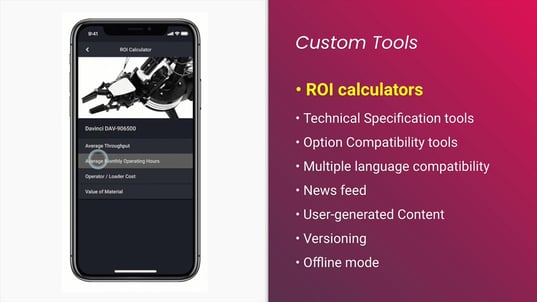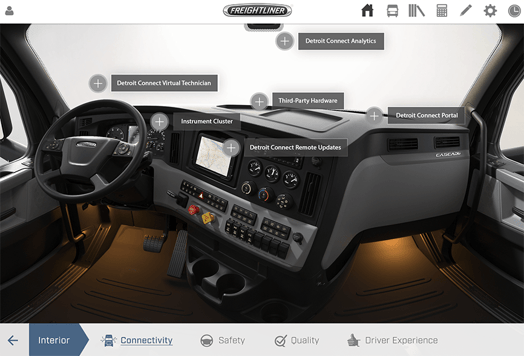A well-designed and accurately executed sales training program is the lifeblood of any sales-focused business. In the equipment distribution sector, it is extremely important. Sales programs and sales training apps empower sales representatives to understand the ins and outs of the products they sell.
How Do You Create an Effective Sales Training Program for Equipment Distributors?
An effective sales training program is critical in heavy equipment distribution, providing dealers and distributors with the essential skills to close deals and enables them to provide exceptional service to clients.
This article will discuss building an effective sales training program, establishing deep product knowledge, showing how to create a high-performing distributor network. It will also be easier to fully comprehend the sales process and business training in real-time.
Having a Hard Time Increasing Distributor Sales Effectiveness?
Embedding a successful sales training program into your equipment distribution strategy can significantly increase your business' effectiveness. Here's how you can create an effective training program and why distributor sales enablement is a powerful weapon.
Firstly, understand that the foundation of any successful training program lies in its design. Construct your program around the unique needs of your organization, and ensure it encompasses all areas of your business.
The training should include product knowledge, sales techniques, customer service skills, and the technology tools needed for optimum performance. Start by identifying the core competencies your salespeople need to excel in their roles. Once established, create objectives and measurable outcomes to assess their progress and mastery.
The Product Knowledge Gap
You must not overlook product knowledge, a vital element, in your program. Equip your sales team with comprehensive knowledge about your equipment. They should understand not just the features of the product, but also its benefits. In-depth product knowledge is key to increasing their confidence, allowing them to communicate effectively with customers and, ultimately, driving sales.
Take time to provide detailed training about each piece of equipment your company distributes. Include real-life applications, potential issues, and troubleshooting tips. Providing practical, hands-on experiences with the equipment is also incredibly valuable for reinforcing learning.
Sales Training Process
A solid understanding of the sales training process is crucial. This begins with engaging training materials that resonate with your team's learning styles. Utilize a mix of in-person sessions, e-learning modules, video demonstrations, and simulations to cater to different learning preferences.
The sales training process should also include continuous feedback and assessments. This helps ensure your sales team retains the information and applies it effectively in their interactions with customers. Regular performance reviews and constructive feedback help identify areas for improvement and further training.
Lastly, remember that training should not be a one-off event. It should be ongoing and adaptive to the evolving needs of the sales team, market trends, and product advancements. This will keep your sales team up-to-date, competent, and ready to meet the changing demands of customers.
Developing an effective sales training program requires a thoughtful approach and a comprehensive understanding of your products. By implementing such a program, equipment distributors can improve their sales performance, leading to increased usefulness and customer satisfaction.
Low distributor engagement got you down?

How to Build an Effective Training Program
Identify the Goals and Objectives
The first step in building an effective sales training program involves identifying clear, measurable objectives. What do you want your sales team to accomplish for their product or service?
Objectives might range from improving overall sales performance, improving selling skills, enhancing product knowledge, or bolstering customer service. Others can be cold calling or even acquiring phone skills to sell products to even more customers. Telephone sales training can be another path to acquiring customers. Ensure the goals align with your business strategy to establish a relevant, valuable program.
Know your Audience
Recognize that your sales team comprises individuals with diverse strengths, weaknesses, and learning styles. Some might excel at negotiation but struggle with digital technology in the industrial world. However, others might be proficient in technical aspects but lack strong communication skills. Create a mixed-format program that caters to these varying needs and preferences.
To effectively address the diverse strengths, weaknesses, and learning styles of your sales team, it is crucial to create a training program that combines various formats and approaches. This mixed-format program will ensure that each individual receives the necessary support and resources to enhance their skills and excel in their roles.
For those who excel at negotiation but struggle with digital technology, consider incorporating hands-on workshops or interactive training sessions that focus specifically on digital tools and technologies used in the industrial sector. These workshops can provide practical guidance and support to help them navigate and leverage technology effectively in their sales processes.
On the other hand, for individuals who are proficient in technical aspects but lack strong communication skills, consider integrating communication-focused modules into the training program. These modules can include role-playing exercises, communication workshops, and interactive discussions that allow participants to practice and improve their communication skills. Additionally, providing resources such as communication guides or tips can further assist them in developing effective communication strategies.
It is important to remember that everyone learns differently, and a one-size-fits-all approach may not be effective in addressing the diverse needs of your sales team. By creating a mixed-format program that combines different training methods, such as in-person sessions, e-learning modules, video demonstrations, and simulations, you can cater to different learning preferences and ensure that each individual receives the support they need to succeed.
Ultimately, a training program that recognizes and accommodates the diverse strengths, weaknesses, and learning styles of your sales team will not only enhance their overall performance but also foster a more inclusive and supportive work environment.
Curate Relevant Content
Equip your team with the knowledge and skills they need to excel by providing a comprehensive training program that covers a wide range of topics. In addition to insights about your product and industry, sales techniques, negotiation skills, communication skills, and customer relationship management, consider incorporating other valuable areas of expertise.
For example, you could include modules on time management to help your sales team prioritize their tasks and maximize their productivity. You could also offer training on emotional intelligence, teaching them how to navigate challenging customer interactions with empathy and understanding.
To make the content engaging and interactive, consider incorporating case studies that allow your team to apply their knowledge and skills to real-life scenarios. Role-plays can also be effective in helping them practice and refine their techniques in a safe and supportive environment. Additionally, consider implementing gamified learning strategies, such as quizzes or competitions, to make the training more enjoyable and encourage active participation.
By providing a well-rounded training program that goes beyond the basics, you can ensure that your team is equipped with the knowledge and skills necessary to excel in their roles. This will not only benefit their individual performance but also contribute to the overall success of your sales team and organization.
Implement a Blended Learning Approach
To create a more effective and engaging training program, it is beneficial to implement a blended learning approach that combines traditional classroom training with digital learning solutions. By incorporating e-learning platforms, you can provide a more flexible and self-paced learning experience for your sales team.
Utilize interactive videos that allow participants to actively engage with the material and enhance their understanding. These videos can include demonstrations of sales techniques, product presentations, or role-playing scenarios that simulate real-life customer interactions. This interactive element not only keeps learners engaged but also helps them apply their knowledge in practical situations.
Webinars are another valuable tool that can be used to deliver training content. These live online sessions provide an opportunity for real-time interaction and discussion, allowing participants to ask questions and receive immediate feedback. Webinars can cover a wide range of topics, from sales strategies to product updates, and can be recorded and made available for future reference.
Online quizzes are an effective way to assess learners' understanding of the material and reinforce key concepts. By incorporating quizzes throughout the training program, you can ensure that participants are retaining the information and identify areas that may require additional focus. These quizzes can be designed to provide instant feedback, allowing learners to track their progress and identify areas for improvement.
In addition to interactive videos, webinars, and quizzes, social learning platforms can also be utilized to enhance the training experience. These platforms provide a space for participants to collaborate, share ideas, and learn from one another. By creating a community of learners, you can foster a culture of continuous learning and provide ongoing support and resources.
By blending traditional classroom training with digital learning solutions, you can create a comprehensive and engaging training program that meets the diverse needs and preferences of your sales team. This blended approach allows for flexibility, self-paced learning, and interactive experiences, ultimately leading to a more effective and impactful training experience.
 Provide Continuous Training and Reinforcement
Provide Continuous Training and Reinforcement
Mobile sales training is not a one-and-done event. It requires continuous effort and commitment to ensure that your sales team remains up-to-date and equipped with the necessary skills to succeed. As the market trends, product advancements, and customer demands continue to evolve, it is crucial to save time and allocate resources to update your training program accordingly.
One way to stay updated is to regularly assess the effectiveness of your training program. Gather feedback from your sales team to understand their needs and challenges. This feedback can help you identify areas that require improvement or additional training. Additionally, keep a close eye on market trends and product updates. Stay informed about industry changes and new technologies that may impact your sales strategies. Incorporate this information into your training program to ensure that your team is well-prepared to adapt and thrive in a dynamic marketplace.
Reinforcement is also key in ensuring the long-term effectiveness of your training program. Regular coaching and feedback sessions can provide valuable guidance and support to your sales team. This allows them to continuously improve their skills and address any areas for development. Consider implementing refresher courses or workshops to reinforce key concepts and provide ongoing learning opportunities. By reinforcing training through these methods, you can help your sales team retain knowledge, strengthen their skills, and ultimately improve their performance.
In conclusion, mobile sales training should be viewed as an ongoing process rather than a one-time event. By saving time to update your program based on market trends, product updates, and team feedback, and reinforcing training through regular coaching, feedback sessions, and refresher courses, you can ensure that your sales team remains competent, adaptable, and ready to meet the changing demands of customers.
Cultivating Product Knowledge
Provide Comprehensive Product Training
Sales reps or sales managers need to have an intimate understanding of the products they're selling. This knowledge should go beyond mere features and specifications. They should understand how the product works, its benefits, and how it compares to competitors. This level of product knowledge is crucial for effective sales conversations and building trust with customers.
To cultivate this understanding, it is essential to conduct detailed product demos and provide hands-on training. Product demos allow sales reps to showcase the features and functionality of the product in a real-world context. This can be done through live demonstrations or recorded videos that highlight key aspects of the product. By seeing the product in action, sales reps can better understand its capabilities and how it can address customer needs.
In addition to demos, hands-on training is another effective way to enhance product knowledge. This can involve providing opportunities for sales reps to use the product themselves, either through simulation or by providing access to a demo version. By using the product firsthand, sales reps can gain a deeper understanding of its intricacies, potential challenges, and how it can be customized to meet specific customer requirements.
To support ongoing learning and reference, it is also important to equip sales reps with resources such as product guides and FAQs for cloud-based tech. These resources should be comprehensive, easy to navigate, and regularly updated to reflect any product updates or changes. Product guides can provide detailed explanations of how the product works, its various features, and potential use cases. FAQs can address common customer inquiries and provide sales reps with ready-made responses to confidently address customer concerns.
By investing in comprehensive product training and providing resources for ongoing learning, sales reps can develop a deep understanding of the products they are selling. This knowledge will empower them to have meaningful conversations with customers, effectively address objections, and highlight the unique value proposition of the product. Ultimately, this will lead to increased customer confidence, higher sales conversions, and a stronger competitive advantage in the market.
Understand Customer Needs and Pain Points
To truly equip sales reps with the knowledge they need to excel, it is crucial to provide them with a deep understanding of the problems your product solves for customers. This means going beyond surface-level features and specifications and delving into the core challenges that your target audience faces.
Start by conducting thorough research on your target market and customer base. Understand their needs, pain points, and goals. This will allow you to tailor your product training to address their specific challenges and demonstrate how your product can provide a solution.
One effective way to equip sales reps with this knowledge is to create buyer personas. These personas represent your ideal customers and provide a detailed description of their characteristics, preferences, and pain points. By understanding these personas, sales reps can better empathize with customers and position your product as the solution they've been searching for.
Additionally, consider providing sales reps with case studies or success stories that highlight how your product has helped previous customers overcome their challenges. These real-life examples not only demonstrate the value of your product but also provide sales reps with tangible evidence to support their sales conversations.
Furthermore, ongoing communication and collaboration between sales and customer support teams can be invaluable in equipping sales reps with knowledge about customer needs and pain points. Customer support teams often have direct interactions with customers and can provide valuable insights into the challenges they face. Regular meetings or shared documentation can help bridge the gap between these teams and ensure that sales reps have access to up-to-date information about customer needs.
Overall, equipping sales reps with knowledge about customer needs, challenges, and how your product can address these pain points is essential for their success. By providing them with a deep understanding of the problems your product solves, you empower them to have meaningful conversations with customers and position your product as the ideal solution. This knowledge will not only increase their confidence but also enhance their ability to close deals and build long-lasting customer relationships.
Stay Updated on Product Changes and Industry Trends
To keep the sales team informed and up-to-date, it is essential to establish effective communication channels that facilitate the sharing of product changes and industry developments. Regular product update sessions can be scheduled to provide in-depth information about any updates or enhancements to the products being sold. These sessions can be conducted by subject matter experts who can explain the changes, their impact, and how they can be leveraged to meet customer needs.
In addition to update sessions, newsletters can be distributed on a regular basis to provide concise yet informative updates about product changes and industry trends. These newsletters can include highlights of any new features or functionalities, case studies showcasing successful implementations, and insights into emerging industry trends. By delivering this information directly to the sales team's inbox, they can quickly and easily stay informed and incorporate the latest developments into their sales conversations.
Sharing industry news and trends is another effective way to keep the sales team updated and informed. This can be done through a dedicated communication channel, such as a group chat or a shared document, where sales representatives can post relevant articles, reports, or insights they come across. Encouraging active participation and engagement in sharing industry news can foster a culture of continuous learning and ensure that the sales team remains knowledgeable about the latest trends and developments in the market.
By implementing these communication strategies, the sales team can stay updated about product changes and industry trends, enabling them to adapt their sales strategies accordingly. This knowledge equips them with the necessary information to confidently address customer inquiries, highlight the value of the products, and stay ahead of the competition. Ultimately, by keeping the sales team well-informed, you can maximize their effectiveness and drive better results for your organization.
Create a Culture of Learning
To create a culture of continuous learning, it is important to encourage and reward employees for their dedication to ongoing development. One way to do this is by making learning resources readily available and easily accessible to all team members. This can include providing access to online courses, industry publications, and educational materials that can be accessed at any time.
In addition to providing resources, it is crucial to actively promote and encourage continuous learning within the organization. This can be done through regular communication and reminders about the importance of staying updated and acquiring new skills. Managers can lead by example by participating in their own professional development and sharing their experiences with the team. By fostering a supportive environment that values learning, employees will feel encouraged to take the initiative to expand their knowledge and skills.
Recognition and rewards are also powerful motivators for continuous learning. When employees demonstrate a commitment to learning and development, it is important to acknowledge their efforts and celebrate their achievements. This can be done through public recognition, such as employee spotlights or shout-outs during team meetings, as well as tangible rewards such as gift cards, additional time off, or opportunities for advancement. By acknowledging and rewarding continuous learning, employees will feel valued and motivated to continue growing and improving.
Overall, creating a culture of continuous learning requires a proactive approach that includes making learning resources easily accessible, promoting the importance of ongoing development, and recognizing and rewarding employees' dedication to learning. By fostering an environment that values learning, organizations can ensure that their employees are equipped with the knowledge and skills necessary to succeed in a rapidly changing business landscape.
Understanding the Sales Training Process
Assess Training Needs
Once you have identified the need for sales training, it is crucial to begin the process by assessing the specific needs of your sales team. This assessment will help you identify any gaps in their skills and knowledge, allowing you to tailor your training program to address these areas effectively.
One method of assessing training needs is through performance reviews. By evaluating the performance of each sales team member, you can identify areas where they may be struggling or where they could benefit from additional training. Look for patterns or common areas of improvement across the team to determine which skills or knowledge gaps are most prevalent.
Surveys can also be a valuable tool for assessing training needs. By asking your sales team to provide feedback on their own skills and knowledge, as well as areas where they feel they could benefit from further training, you can gather valuable insights. This feedback can help you identify specific areas of focus for your training program and ensure that it addresses the needs of your team.
Additionally, direct feedback from sales team members is essential for assessing training needs. Encourage open and honest communication, and provide opportunities for team members to share their thoughts and concerns about their own skills and knowledge gaps. This feedback can provide valuable insights and help you tailor your training program to the specific needs of your sales team.
By conducting a thorough assessment of training needs through performance reviews, surveys, and direct feedback, you can gather a comprehensive understanding of the specific gaps in your sales team's skills and knowledge. This assessment will serve as a foundation for designing a training program that is tailored to address these gaps effectively, ensuring that your sales team receives the training they need to excel.
Design the Training Program
After identifying the training needs, it is crucial to design a comprehensive and effective training program that aligns with your objectives. This involves setting clear and measurable training goals, carefully curating the content, selecting the most suitable training methods, and establishing a realistic timeline for the training.
Setting training objectives is essential to ensure that your program addresses the specific needs and goals of your sales team. These objectives should be specific, measurable, achievable, relevant, and time-bound (SMART). For example, if the training needs assessment revealed that the team lacks effective communication skills, one of your objectives could be to improve their ability to effectively communicate with customers and colleagues.
Curating the content for your training program involves selecting and organizing the information and materials that will be used to deliver the training. This could include creating or sourcing relevant training materials, such as presentations, videos, case studies, and interactive activities. It is important to ensure that the content is engaging, relevant, and tailored to the specific needs of your sales team.
Deciding on the training methods involves choosing the most effective and efficient ways to deliver the training content to your sales team. This could include a combination of in-person training sessions, virtual training modules, on-the-job training, role-playing exercises, and interactive workshops. It is important to consider the learning preferences and needs of your sales team when selecting the training methods.
Setting a realistic timeline for the training is crucial to ensure that it is completed within a reasonable timeframe and does not disrupt the daily operations of your sales team. Consider the availability and schedules of your sales reps when determining the duration and frequency of the training sessions. It is also important to allow enough time for practice, reinforcement, and evaluation of the skills and knowledge acquired during the training.
By designing a well-structured and comprehensive training program that includes clear objectives, curated content, suitable training methods, and a realistic timeline, you can effectively address the training needs of your sales team. This will enable them to acquire the necessary skills and knowledge to excel in their roles and drive better results for your organization.
Implement the Training
When it comes to delivering the training, it is important to consider the different methods that can be used to effectively engage and educate your sales team. A mix of classroom training, e-learning, on-the-job training, and coaching can provide a well-rounded and comprehensive approach.
Classroom training allows for direct interaction and engagement with the trainer and other team members. It provides an opportunity for discussions, role-playing exercises, and group activities that can enhance learning and promote collaboration. This method is particularly effective for introducing new concepts, teaching sales techniques, and facilitating knowledge sharing among team members.
E-learning, on the other hand, offers flexibility and convenience. It allows sales team members to access training materials and modules at their own pace and convenience. E-learning platforms can provide interactive modules, quizzes, and assessments that ensure active participation and knowledge retention. This method is especially useful for reinforcing learning, providing ongoing training, and accommodating remote team members.
On-the-job training is an invaluable method that allows sales team members to learn and practice their skills in real-life scenarios. It involves shadowing experienced sales representatives, participating in customer meetings, and gradually taking on more responsibilities. This hands-on approach helps sales team members gain practical experience, refine their skills, and build confidence in their abilities.
Coaching is an essential component of any training program. It involves one-on-one sessions with a coach or mentor who provides guidance, feedback, and support to individual sales team members. Coaching can help identify areas for improvement, address specific challenges, and provide personalized guidance to help sales team members reach their full potential. It is a valuable method for developing sales skills, enhancing performance, and fostering continuous growth.
By utilizing a mix of classroom training, e-learning, on-the-job training, and coaching, you can create a comprehensive and engaging training program that caters to the diverse learning needs of your sales team. This approach ensures that each team member receives the necessary knowledge and skills to excel in their role and contribute to the overall success of your organization.
Evaluate the Training
Once the training program has been implemented, it is essential to evaluate its effectiveness to ensure that it is helping the sales team improve their skills and achieve better results. One way to evaluate the program is by tracking key metrics such as sales performance and deal closure rate. By comparing these metrics before and after the training, you can determine if there has been a positive impact on the team's performance.
In addition to tracking metrics, it is crucial to collect feedback from the sales team about the training program. This feedback can provide valuable insights into the effectiveness of the program and highlight any areas for improvement. Conduct surveys or hold focus groups to gather feedback from the team members. Encourage them to share their thoughts on the training content, delivery methods, and overall effectiveness. This feedback can help identify any gaps or shortcomings in the program and guide you in making necessary improvements.
When analyzing the feedback, look for common themes or patterns. Are there specific areas of the training that received positive feedback? Are there any recurring concerns or suggestions for improvement? Use this feedback to identify specific areas where adjustments can be made to enhance the training program.
Based on the evaluation and feedback, make the necessary improvements to the training program. This could involve updating the content, adjusting the delivery methods, or incorporating additional resources or support. Regularly review and update the program to ensure it remains relevant and effective in meeting the evolving needs of the sales team.
By continuously evaluating the effectiveness of the training program and making improvements based on feedback, you can ensure that your sales team receives the most valuable and impactful training. This will contribute to their ongoing development and help them achieve their full potential, ultimately driving better results for your organization.
Revise and Repeat
Based on the evaluation, revise your training program to better address the needs of your sales team. Repeat this process of assessment, design, implementation, and evaluation to ensure your training program stays relevant and effective.
In conclusion, developing a successful sales training program for equipment distributors requires meticulous planning and tailored content. It also demands a blend of teaching methods, continuous reinforcement, and a deep understanding of the product.
It's an iterative process that evolves with your team's needs, market trends, and business goals. Remember, a well-trained sales team is not just about higher sales. It's about building strong customer relationships, enhancing brand reputation, and driving long-term business growth.






